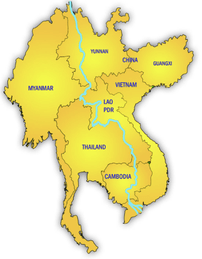From the soaring heights of the Tibetan Plateau in China’s Yunnan province, through the lush lowland plains of Vietnam where the Mekong spills into the Gulf of Thailand, the Greater Mekong Subregion encompasses limestone mountain formations, broad river valleys, fertile plains, and verdant tropical jungle.
The GMS slices through China, Myanmar, Thailand, Laos, Cambodia and Vietnam, covers 2.6 million square kilometers, and is home to 326 million people. Rich in human and natural resource potential, it is expected that by 2015, in partnership with China, the GMS will be the world’s largest trading block.
Challenges & Opportunities
The Mekong region bridges South, Southeast and East Asia. It encompasses countless ethnic groups, hundreds of languages, and the entire political and human development spectrum. Of its 337 million people, one third – or over 100 million – live in poverty.
While the countries of the GMS are becoming increasingly modernized and industrialized, the process is a slow one. A great majority of the Mekong region’s peoples continue to lead subsistence or near subsistence lifestyles. A transition is taking place to more diversified economies and opening to market-based systems, however the process is gradual.
The challenge is to ensure economic growth that is undergirded by quality and equality; that ensures social protection and safeguarding of human rights; and that provides a new generation of youth with adequate skills to find gainful employment in a rapidly changing environment.
Shift360 addresses the needs of the Mekong Region context by creating gainful employment, developing human capital and influencing leaders.
It is a 360 degree approach that brings government, the private and non-profit sectors, and religious and academic leaders to the table to ensure economic growth and development is in the best interest of the entire community. This article is available in PDF.
Asian Development Bank. Online: http://www.adb.org/countries/gms/main

